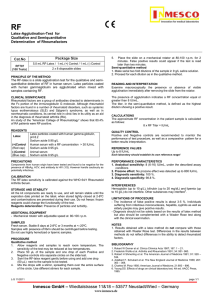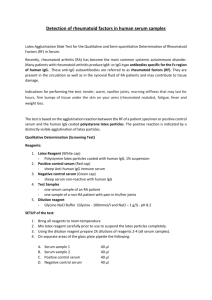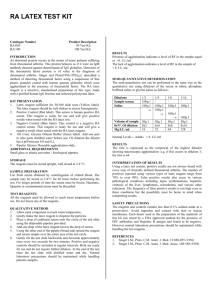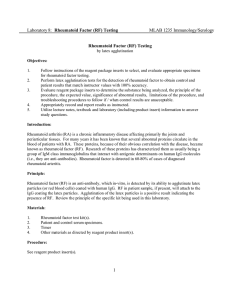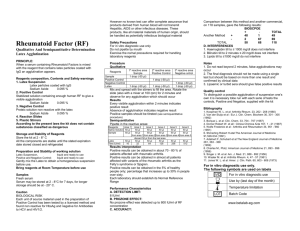ACCUTEX RHEUMATOID FACTOR (RF) LATEX TEST QuAlitAtive
advertisement
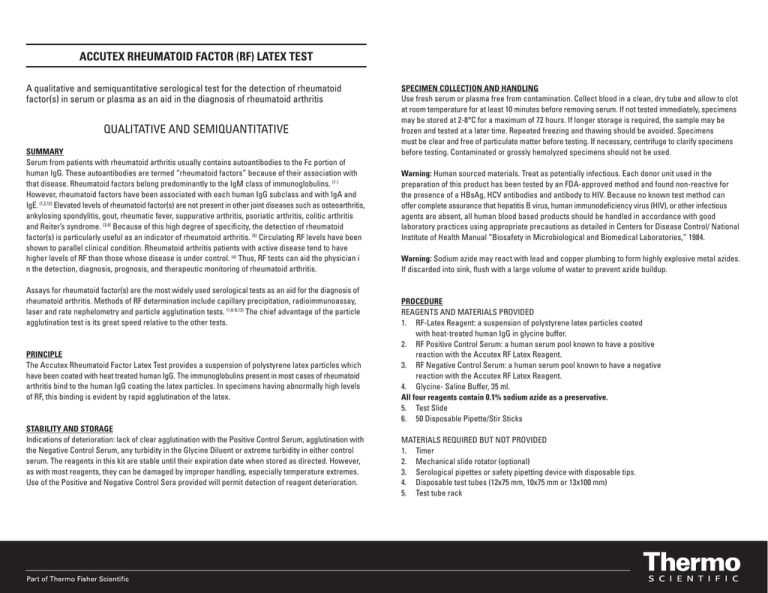
ACCUTEX RHEUMATOID FACTOR (RF) LATEX TEST A qualitative and semiquantitative serological test for the detection of rheumatoid factor(s) in serum or plasma as an aid in the diagnosis of rheumatoid arthritis Qualitative and Semiquantitative SUMMARY Serum from patients with rheumatoid arthritis usually contains autoantibodies to the Fc portion of human IgG. These autoantibodies are termed “rheumatoid factors” because of their association with that disease. Rheumatoid factors belong predominantly to the IgM class of immunoglobulins. (1 ) However, rheumatoid factors have been associated with each human IgG subclass and with IgA and IgE. (1,2,12) Elevated levels of rheumatoid factor(s) are not present in other joint diseases such as osteoarthritis, ankylosing spondylitis, gout, rheumatic fever, suppurative arthritis, psoriatic arthritis, colitic arthritis and Reiter’s syndrome. (3,4) Because of this high degree of specificity, the detection of rheumatoid factor(s) is particularly useful as an indicator of rheumatoid arthritis. (5) Circulating RF levels have been shown to parallel clinical condition. Rheumatoid arthritis patients with active disease tend to have higher levels of RF than those whose disease is under control. (4) Thus, RF tests can aid the physician i n the detection, diagnosis, prognosis, and therapeutic monitoring of rheumatoid arthritis. Assays for rheumatoid factor(s) are the most widely used serological tests as an aid for the diagnosis of rheumatoid arthritis. Methods of RF determination include capillary precipitation, radioimmunoassay, laser and rate nephelometry and particle agglutination tests. (1,6-8,12) The chief advantage of the particle agglutination test is its great speed relative to the other tests. PRINCIPLE The Accutex Rheumatoid Factor Latex Test provides a suspension of polystyrene latex particles which have been coated with heat treated human IgG. The immunoglobulins present in most cases of rheumatoid arthritis bind to the human IgG coating the latex particles. In specimens having abnormally high levels of RF, this binding is evident by rapid agglutination of the latex. Stability and Storage Indications of deterioration: lack of clear agglutination with the Positive Control Serum, agglutination with the Negative Control Serum, any turbidity in the Glycine Diluent or extreme turbidity in either control serum. The reagents in this kit are stable until their expiration date when stored as directed. However, as with most reagents, they can be damaged by improper handling, especially temperature extremes. Use of the Positive and Negative Control Sera provided will permit detection of reagent deterioration. Specimen collection and HANDLING Use fresh serum or plasma free from contamination. Collect blood in a clean, dry tube and allow to clot at room temperature for at least 10 minutes before removing serum. If not tested immediately, specimens may be stored at 2-8°C for a maximum of 72 hours. If longer storage is required, the sample may be frozen and tested at a later time. Repeated freezing and thawing should be avoided. Specimens must be clear and free of particulate matter before testing. If necessary, centrifuge to clarify specimens before testing. Contaminated or grossly hemolyzed specimens should not be used. Warning: Human sourced materials. Treat as potentially infectious. Each donor unit used in the preparation of this product has been tested by an FDA-approved method and found non-reactive for the presence of a HBsAg, HCV antibodies and antibody to HIV. Because no known test method can offer complete assurance that hepatitis B virus, human immunodeficiency virus (HIV), or other infectious agents are absent, all human blood based products should be handled in accordance with good laboratory practices using appropriate precautions as detailed in Centers for Disease Control/ National Institute of Health Manual “Biosafety in Microbiological and Biomedical Laboratories,” 1984. Warning: Sodium azide may react with lead and copper plumbing to form highly explosive metal azides. If discarded into sink, flush with a large volume of water to prevent azide buildup. PROCEDURE Reagents and Materials Provided 1. RF-Latex Reagent: a suspension of polystyrene latex particles coated with heat-treated human IgG in glycine buffer. 2. RF Positive Control Serum: a human serum pool known to have a positive reaction with the Accutex RF Latex Reagent. 3. RF Negative Control Serum: a human serum pool known to have a negative reaction with the Accutex RF Latex Reagent. 4. Glycine- Saline Buffer, 35 ml. All four reagents contain 0.1% sodium azide as a preservative. 5. Test Slide 6. 50 Disposable Pipette/Stir Sticks Materials Required but not Provided 1. Timer 2. Mechanical slide rotator (optional) 3. Serological pipettes or safety pipetting device with disposable tips. 4. Disposable test tubes (12x75 mm, 10x75 mm or 13x100 mm) 5. Test tube rack ProcedurE A. Qualitative Test 1. Bring reagents and specimens to room temperature before use. 2. Place one drop (50 ul) of the RF Positive Control on the first field of the reaction slide. Place one drop (50 ul) of the RF Negative Control on the second field. The remaining fields are used for test specimens. Using pipettes provided, place one drop of each specimen on successive fields. Retain the Pipette/Stir Sticks for mixing step. 3. Gently resuspend the RF Latex Reagent and add one drop to each test field. Use Pipette/Stir Stick to spread reaction mixture over entire test field. 4. Rotate slide for 3 minutes and read immediately under direct light. LIMITATIONS OF TEST PROCEDURES Although the Accutex RF Latex Reagent is highly sensitive and specific, a diagnosis of rheumatoid arthritis should not be made on the basis of a positive test result without the support of patient history and other clinical evidence. Similarly, a negative test result cannot completely rule out rheumatoid arthritis. Incubation of the test for longer than the recommended time may cause false positive reactions. B. 1. 2. 3. 4. Specific Performance Characteristics Serum and plasma specimens from one hundred and fifty two (152) individuals which had been submitted to clinical laboratories by physicians for RF testing were examined. The Accutex RF Latex Test and another commercial latex kit were used to screen the specimens. Qualitatively, forty-eight (48) specimens (38.4%) were found positive using both latex kits. Semiquantitatively, positive RF titers ranged from 20 to 10,240. There was no more than one titer dilution difference between the two assays. In another study, serum and plasma samples from seventy-five (75) apparently healthy individuals were also tested with both assays. All 75 samples from healthy specimens gave negative results with both assays. This data indicates that both the sensitivity and specificity between the two assays were 100%. 5. Semiquantitative Test Bring reagents and specimens to room temperature before use. Using the Glycine-Saline Buffer, dilute the specimens 1:2, 1:4, 1:8, 1:16, 1:32, or as needed. Place one drop (50 ul) of each dilution on successive fields of the reaction slide. Gently resuspend the RF Latex Reagent and add one drop to the reaction slide. Use Pipette/Stir Stick to spread reaction mixture over entire test field. Rotate slide for 3 minutes and read immediately under direct light. Quality Control RF Positive and Negative Control Sera should be included in each test series. The Positive Control Serum should produce clear agglutination; the Negative Control Serum should produce no agglutination. RESULTS The Accutex RF Latex Reagent is designed to agglutinate in the presence of RF levels of approximately 15 IU/ml or greater with an undiluted sample. A. Qualitative Test Agglutination (positive reaction) indicates the level of rheumatoid factor(s) in the undiluted test sample is approximately 15 IU/ml or greater. Positive test specimens should be subjected to the Semiquantitative Test. The lack of agglutination (negative reaction) indicates the level of rheumatoid factor(s) is within normal range. B. Semiquantitative Test The titer of rheumatoid factors is the reciprocal of the highest dilution which exhibits a positive reaction. The level of RF in IU/ml in the undiluted test sample is approximately 15 times the titer (example: endpoint dilution = 1:32; titer = 32; RF (IU/ml) = 32 x 15 = 480 IU/ml). The actual concentration of RF has been found to parallel clinical condition and is useful in staging and determining prognosis. Repeat testing on samples obtained at intervals may be very useful in monitoring a patient’s response to therapy. (5) Apparently normal, healthy persons may have rheumatoid factor(s). These individuals usually have low titers. The incidence of positive reactions in this group increases with age and is similar in females and males. In a study on precision, a panel of 10 serum samples with RF titers from 20 to 1280 were tested on 10 consecutive days by the Semiquantitative Test method (100 determinations). No determinations gave more than a 2-fold difference from the mean titer for a sample. REFERENCES 1. Panush, R.S., N.E. Bianco and P.H. Schur. 1971. Arth. Rheum. 14:737. 2. Shakib, F. and D.R. Stanworth. 1978. Ann. Rheum. Dis. 37:12. 3. Sharp, J.T., R. Calkins, A.S. Cohen, A.F. Schubert and J.J. Calabro. 1964. Medicine. 43:41. 4. Freyburg, R.H. 1972. Postgrad. Med. 51:22. 5. Bunim, J.J. (ed.) 1956. Bulletin on Rheumatic Diseases, Volume VII. Arthritis and Rheumatism Foundation. 6. Waeler, E. 1940. Acta. Pathol. et Microbiol. Scand. 17:172. 7. Rose, H.M., E. Ragan, E. Pearce and M.O. Lipman. 1948. Proc. Soc. Exptl. Biol. Med. 68:1. 8. Singer, J.M. and C.M. Plotz. 1956. Amer. J. Med. 21:888. 9. Dequeker, J., R. Van Noyen and J. Vandepitte. 1969. Ann. Rheum. Dis. 28:431. 10. Hooper, B., S. Whittingham, J.D. Mathews, I.R. McKay and D.H. Currow. 1972. Clin. Exp. Immunol. 12:79. 11. Christian, C.L. 1971. In M. Samter (ed.) Immunological Diseases Volume II. Little, Brown and Co. Boston, MA. 12. Linker, J.B. and R.C. Williams, Jr. 1985. Tests for detection of rheumatoid factors. In N.R. Rose, H. Friedman and J.C. Fahey (ed.) Manual of clinical laboratory immunology. Third ed. American Society for Microbiology. Washington DC. NERL Diagnostics LLC East Providence, RI 02914 | 800-556-7575 NRL736AI | Rev. 12/08
